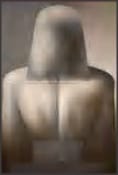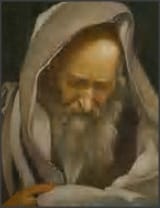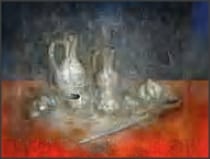Roman Kriheli: An Artist’s Transformation

World-Tier Artists rarely escape the need for periodic and transformative re-invention, as they inevitably rejuvinate their artistic genre.
No exception to this premise, Georgia’s leading contemporary master of classic and modern painting, Roland Simon Kriheli has been an enduring force in the post-Soviet non-conformist genre of art-in-exile for well over thirty years.
Following its newsmaking theft, and after an international search that spanned multiple continents, the legendary Roman Kriheli masterpiece — ‘The Most Beautiful Woman’ — finally resurfaced in 2018, and thus returned into the artist’s hands, for an extensive, if only partially-successful, restoration.
The $4M work in oil vanished following its exhibition at 2014 Art Basel Miami, where it received rave reviews. The remarkable painting is exmplified the signature-style of the rarely-seen Kriheli, who lives in North America. At the time the painting vanished, international sources speculated that — following the painting’s Art Basel premiere gallery exhibition — it was loaned for private display to an undisclosed collector in one of the Gulf States.

Following that private exhibition, the painting subsequently-vanished, and was briefly encountered in the hands of an international art dealer operating out of Mexico. In the autumn of 2018, the painting apparently returned to the hands of the artist. Regrettably, close examination of the painting revealed significant damage to its oil base, due to improper concealment and handling during the masterpiece’s diversion.
According to Roman Kriheli, extensive restoration work is underway, with an uncertain timeline projected towards the painting’s expected re-emergence in public exhibition venues. Prominent European Art Experts inform theNews2 that the notoriety of the painting’s history now promises to increase the provenance valuation of the work well beyond $4M.
A highly-respected painter with a collection of over 350 works attributed to his name, Kriheli is a remarkable and au-contraire member of the Post-Soviet Non-Conformist Art Movement, the latter due to his idiosyncratic classical style, in part heavily-influenced by Titian, Raphael, and other masters of the Italian Renaissance.

If anything, Kriheli’s story is rooted in the Georgian-Jewish diaspora, and exemplifies the quest of an artist in search of his destiny. Arguably one of the oldest integral Jewish communities in the world, with a 2,600 year history, today’s Georgian Jews are the direct descendants of the 600 B.C. Jewish Diaspora that arose from the Babylonian Flight. In the 1970’s and 1980’s, Soviet oppression provided a powerful impetus for major waves of Georgian immigrants to seek new pathways to their historical destiny. Many Georgian Jews were scattered in the shadows of the wind spawned by yet another Diaspora in their ancient history – this time scattering a courageous people from Vienna to Rome, from Tel Aviv to Antwerp, and from Moscow to New York. Today the majority of Georgian Jews and their rich cultural heritage may be found outside of Georgia — in Israel, the NY area, Russia and in Belgium. Not surprisingly, many of Kriheli’s works are rooted in a strong Judaic thematic influence.

The ‘Artist as a Young Man‘ in our story is Roman Simon Kriheli, an aspiring, classically-trained painter. With his family ultimately in tow, as a youthful artist he came to Italy over thirty-five years ago, the land of the Renaissance masters and a pedigree of perfection in the arts.
The ravages of a lost country behind him, his mind and soul were open to a new dimension of existence. The passion of Raphael and Florentine perfection merged with a young man headed for the shores of the Hudson. Hitting New York, his talent blossomed and he began to paint, paint, and paint. The multi-genre, trans-epoch stylist – a phenomenon rarely mastered effectively by one artist – emerged with distinction in the development of Kriheli as a world-class painter.
After taking Soho by storm early into his Manhattan career and unambiguously taking his place as an icon in the NY art scene, Kriheli vanished into obscurity for over a decade. As many great forces in art who preceded and will follow him, Kriheli has gone through emergence, withdrawal rebirth, and re-emergence — as has his enduring art. Despite the intense international interest in ‘The Most Beautiful Woman, the prolific painter Kriheli is best known for other trend-setting works, including ‘Nocturnes’, ‘Haham’, ‘Oracle’, ‘Jour et Nuit’, and a series of well-known Etruscan Still Lives, among countless other memorable works. As the mystery and controversy surrounding the disappearance and re-emergence of his most recent work dissipates, attention by collectors returns to Kriheli’s countless many other significant works.
Ultimately, Kriheli is as much a New York Soho transplant who painted giant portraits of both Madonna and the West-Side Pharaoh, as he is a Jewish-Georgian emigrant and cultural patriot with a defining core belief in Georgia’s independence. Above all, Kriheli’s saga has embodied the story of one Georgian’s voyage, and of an artist in search of transforming horizons.
Transformation is indeed the force of art which has preoccupied Kriheli over the past four years, not to mention the imposed isolation of the CoVid era. His latest works reveal a drastic, albeit likely-momentary, excursion from his original stylistic roots, inclusive a more airy, softer and less parallax-embedded view of both human portraiture and abstract still-lives, depicted in hauntingly-subdued colors and elusive levels of internal contrast.
Today, and to his immense credit as a world-class painter in our time, Kriheli is as unfathomable as he has always been. His works cannot be adequately-described even in the Queen’s English, as the vision he portrays remains as sublimely-mystifying and hypnotic as it has been from the inception of his unique personal art.

Standing in front of any number of life-size Kriheli works is an experience best described as if an observer was standing in front of a portal to another world and another dimension, entry to the infinite depth of which is a mere step away.
Coming face-to-face with a Kriheli painting remains an unforgettably-ethereal and cosmic experience.
Julia Mineeva /Thenews2
















